Eleni Vasilaki
Department of Computer Science, University of Sheffield
In Dialogue with Intelligence: Rethinking Large Language Models as Collective Knowledge
May 28, 2025Abstract:Large Language Models (LLMs) are typically analysed through architectural, behavioural, or training-data lenses. This article offers a theoretical and experiential re-framing: LLMs as dynamic instantiations of Collective human Knowledge (CK), where intelligence is evoked through dialogue rather than stored statically. Drawing on concepts from neuroscience and AI, and grounded in sustained interaction with ChatGPT-4, I examine emergent dialogue patterns, the implications of fine-tuning, and the notion of co-augmentation: mutual enhancement between human and machine cognition. This perspective offers a new lens for understanding interaction, representation, and agency in contemporary AI systems.
Dynamical-VAE-based Hindsight to Learn the Causal Dynamics of Factored-POMDPs
Nov 12, 2024



Abstract:Learning representations of underlying environmental dynamics from partial observations is a critical challenge in machine learning. In the context of Partially Observable Markov Decision Processes (POMDPs), state representations are often inferred from the history of past observations and actions. We demonstrate that incorporating future information is essential to accurately capture causal dynamics and enhance state representations. To address this, we introduce a Dynamical Variational Auto-Encoder (DVAE) designed to learn causal Markovian dynamics from offline trajectories in a POMDP. Our method employs an extended hindsight framework that integrates past, current, and multi-step future information within a factored-POMDP setting. Empirical results reveal that this approach uncovers the causal graph governing hidden state transitions more effectively than history-based and typical hindsight-based models.
Optimising network interactions through device agnostic models
Jan 14, 2024Abstract:Physically implemented neural networks hold the potential to achieve the performance of deep learning models by exploiting the innate physical properties of devices as computational tools. This exploration of physical processes for computation requires to also consider their intrinsic dynamics, which can serve as valuable resources to process information. However, existing computational methods are unable to extend the success of deep learning techniques to parameters influencing device dynamics, which often lack a precise mathematical description. In this work, we formulate a universal framework to optimise interactions with dynamic physical systems in a fully data-driven fashion. The framework adopts neural stochastic differential equations as differentiable digital twins, effectively capturing both deterministic and stochastic behaviours of devices. Employing differentiation through the trained models provides the essential mathematical estimates for optimizing a physical neural network, harnessing the intrinsic temporal computation abilities of its physical nodes. To accurately model real devices' behaviours, we formulated neural-SDE variants that can operate under a variety of experimental settings. Our work demonstrates the framework's applicability through simulations and physical implementations of interacting dynamic devices, while highlighting the importance of accurately capturing system stochasticity for the successful deployment of a physically defined neural network.
Machine learning using magnetic stochastic synapses
Mar 03, 2023Abstract:The impressive performance of artificial neural networks has come at the cost of high energy usage and CO$_2$ emissions. Unconventional computing architectures, with magnetic systems as a candidate, have potential as alternative energy-efficient hardware, but, still face challenges, such as stochastic behaviour, in implementation. Here, we present a methodology for exploiting the traditionally detrimental stochastic effects in magnetic domain-wall motion in nanowires. We demonstrate functional binary stochastic synapses alongside a gradient learning rule that allows their training with applicability to a range of stochastic systems. The rule, utilising the mean and variance of the neuronal output distribution, finds a trade-off between synaptic stochasticity and energy efficiency depending on the number of measurements of each synapse. For single measurements, the rule results in binary synapses with minimal stochasticity, sacrificing potential performance for robustness. For multiple measurements, synaptic distributions are broad, approximating better-performing continuous synapses. This observation allows us to choose design principles depending on the desired performance and the device's operational speed and energy cost. We verify performance on physical hardware, showing it is comparable to a standard neural network.
A perspective on physical reservoir computing with nanomagnetic devices
Dec 09, 2022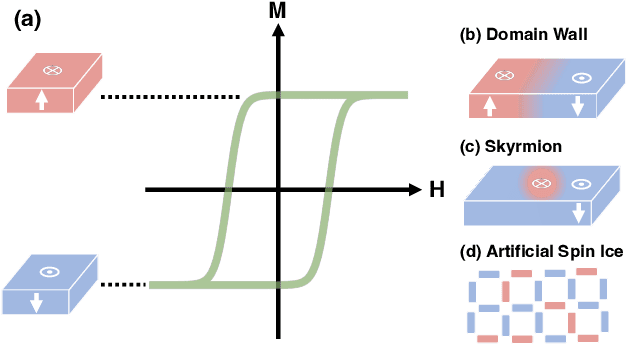
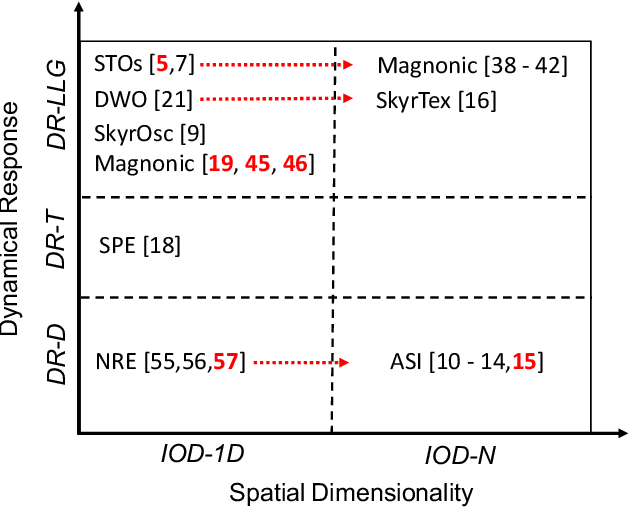
Abstract:Neural networks have revolutionized the area of artificial intelligence and introduced transformative applications to almost every scientific field and industry. However, this success comes at a great price; the energy requirements for training advanced models are unsustainable. One promising way to address this pressing issue is by developing low-energy neuromorphic hardware that directly supports the algorithm's requirements. The intrinsic non-volatility, non-linearity, and memory of spintronic devices make them appealing candidates for neuromorphic devices. Here we focus on the reservoir computing paradigm, a recurrent network with a simple training algorithm suitable for computation with spintronic devices since they can provide the properties of non-linearity and memory. We review technologies and methods for developing neuromorphic spintronic devices and conclude with critical open issues to address before such devices become widely used.
Quantifying the Computational Capability of a Nanomagnetic Reservoir Computing Platform with Emergent Magnetization Dynamics
Nov 29, 2021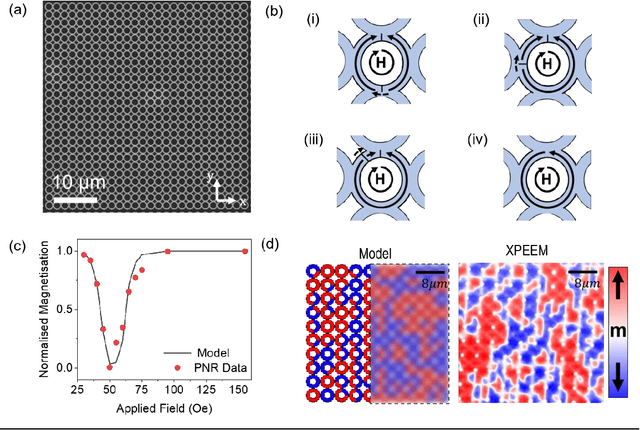
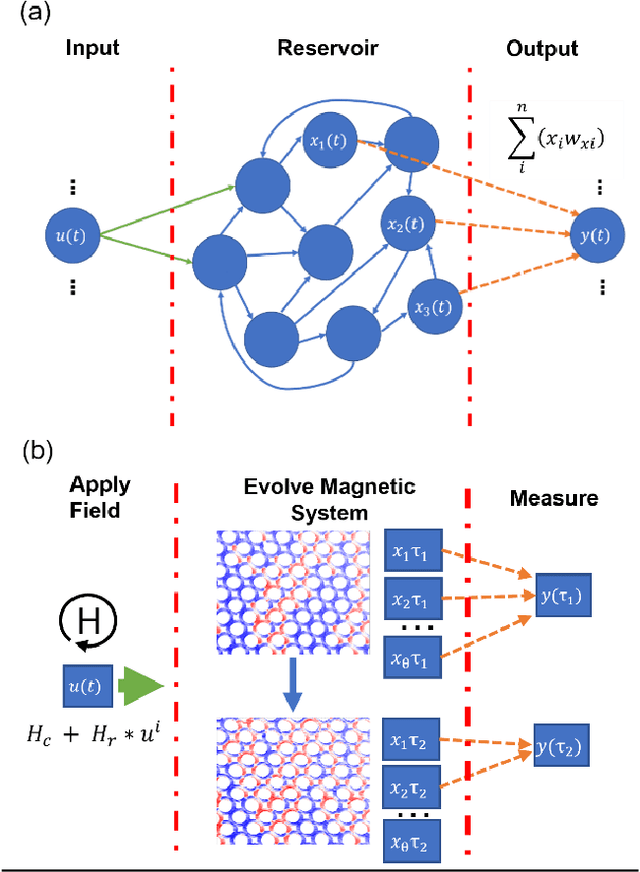


Abstract:Arrays of interconnected magnetic nano-rings with emergent magnetization dynamics have recently been proposed for use in reservoir computing applications, but for them to be computationally useful it must be possible to optimise their dynamical responses. Here, we use a phenomenological model to demonstrate that such reservoirs can be optimised for classification tasks by tuning hyperparameters that control the scaling and input-rate of data into the system using rotating magnetic fields. We use task-independent metrics to assess the rings' computational capabilities at each set of these hyperparameters and show how these metrics correlate directly to performance in spoken and written digit recognition tasks. We then show that these metrics can be further improved by expanding the reservoir's output to include multiple, concurrent measures of the ring arrays' magnetic states.
EchoVPR: Echo State Networks for Visual Place Recognition
Oct 11, 2021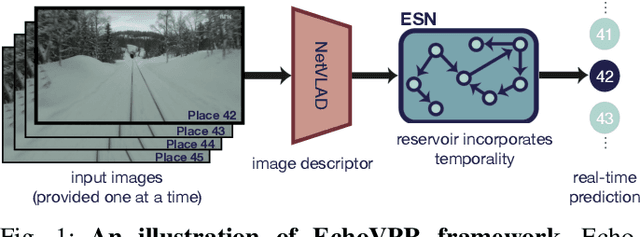

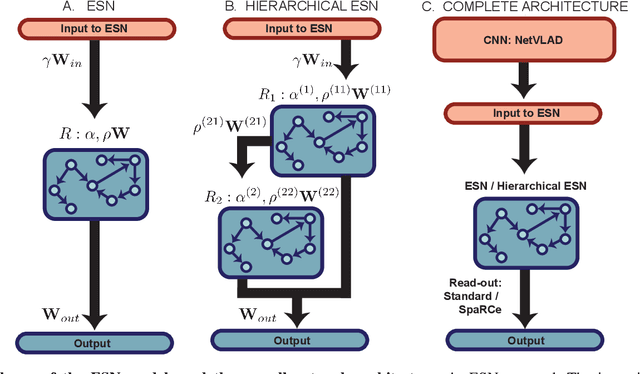
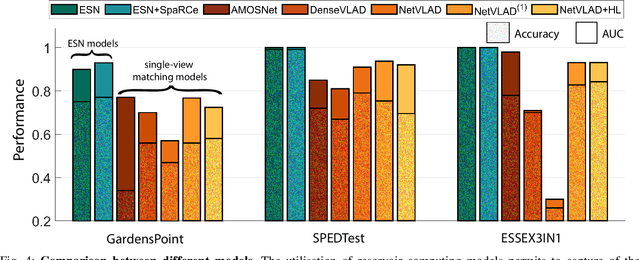
Abstract:Recognising previously visited locations is an important, but unsolved, task in autonomous navigation. Current visual place recognition (VPR) benchmarks typically challenge models to recover the position of a query image (or images) from sequential datasets that include both spatial and temporal components. Recently, Echo State Network (ESN) varieties have proven particularly powerful at solving machine learning tasks that require spatio-temporal modelling. These networks are simple, yet powerful neural architectures that -- exhibiting memory over multiple time-scales and non-linear high-dimensional representations -- can discover temporal relations in the data while still maintaining linearity in the learning. In this paper, we present a series of ESNs and analyse their applicability to the VPR problem. We report that the addition of ESNs to pre-processed convolutional neural networks led to a dramatic boost in performance in comparison to non-recurrent networks in four standard benchmarks (GardensPoint, SPEDTest, ESSEX3IN1, Nordland) demonstrating that ESNs are able to capture the temporal structure inherent in VPR problems. Moreover, we show that ESNs can outperform class-leading VPR models which also exploit the sequential dynamics of the data. Finally, our results demonstrate that ESNs also improve generalisation abilities, robustness, and accuracy further supporting their suitability to VPR applications.
A Robotic Model of Hippocampal Reverse Replay for Reinforcement Learning
Feb 23, 2021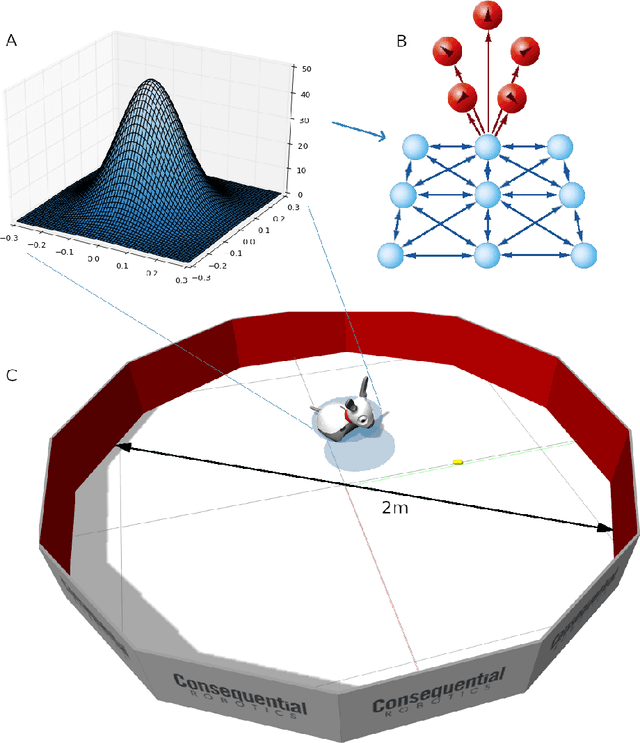


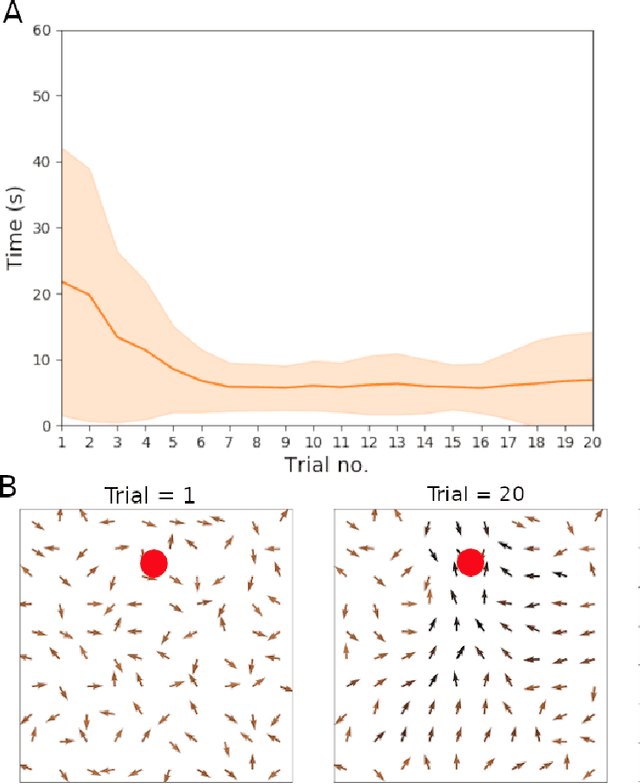
Abstract:Hippocampal reverse replay is thought to contribute to learning, and particularly reinforcement learning, in animals. We present a computational model of learning in the hippocampus that builds on a previous model of the hippocampal-striatal network viewed as implementing a three-factor reinforcement learning rule. To augment this model with hippocampal reverse replay, a novel policy gradient learning rule is derived that associates place cell activity with responses in cells representing actions. This new model is evaluated using a simulated robot spatial navigation task inspired by the Morris water maze. Results show that reverse replay can accelerate learning from reinforcement, whilst improving stability and robustness over multiple trials. As implied by the neurobiological data, our study implies that reverse replay can make a significant positive contribution to reinforcement learning, although learning that is less efficient and less stable is possible in its absence. We conclude that reverse replay may enhance reinforcement learning in the mammalian hippocampal-striatal system rather than provide its core mechanism.
Exploiting Multiple Timescales in Hierarchical Echo State Networks
Jan 14, 2021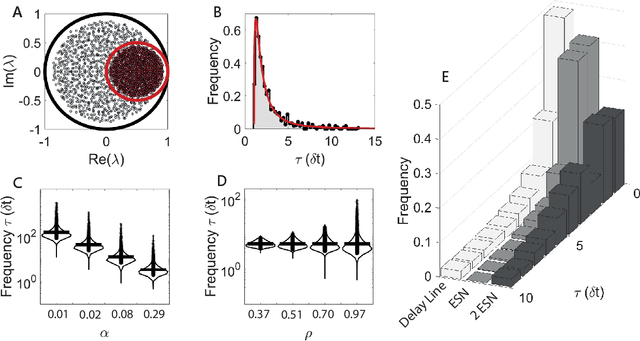
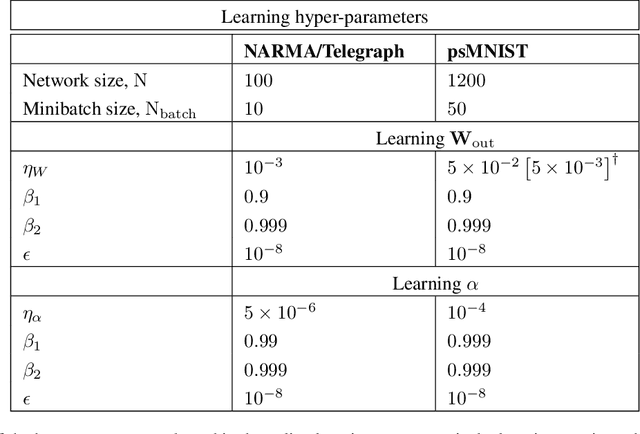
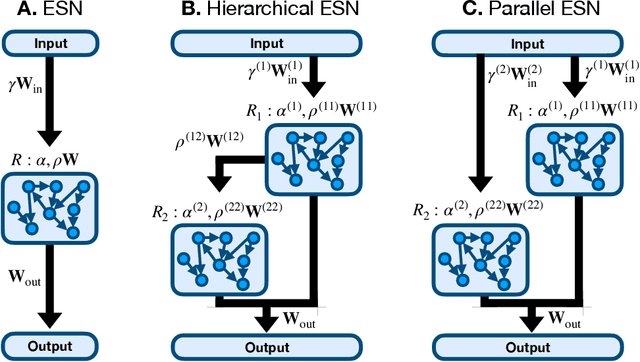
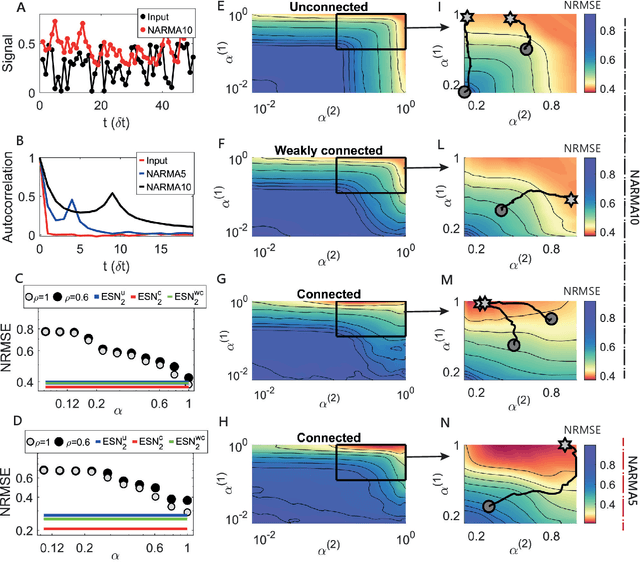
Abstract:Echo state networks (ESNs) are a powerful form of reservoir computing that only require training of linear output weights whilst the internal reservoir is formed of fixed randomly connected neurons. With a correctly scaled connectivity matrix, the neurons' activity exhibits the echo-state property and responds to the input dynamics with certain timescales. Tuning the timescales of the network can be necessary for treating certain tasks, and some environments require multiple timescales for an efficient representation. Here we explore the timescales in hierarchical ESNs, where the reservoir is partitioned into two smaller linked reservoirs with distinct properties. Over three different tasks (NARMA10, a reconstruction task in a volatile environment, and psMNIST), we show that by selecting the hyper-parameters of each partition such that they focus on different timescales, we achieve a significant performance improvement over a single ESN. Through a linear analysis, and under the assumption that the timescales of the first partition are much shorter than the second's (typically corresponding to optimal operating conditions), we interpret the feedforward coupling of the partitions in terms of an effective representation of the input signal, provided by the first partition to the second, whereby the instantaneous input signal is expanded into a weighted combination of its time derivatives. Furthermore, we propose a data-driven approach to optimise the hyper-parameters through a gradient descent optimisation method that is an online approximation of backpropagation through time. We demonstrate the application of the online learning rule across all the tasks considered.
Memristors -- from In-memory computing, Deep Learning Acceleration, Spiking Neural Networks, to the Future of Neuromorphic and Bio-inspired Computing
Apr 30, 2020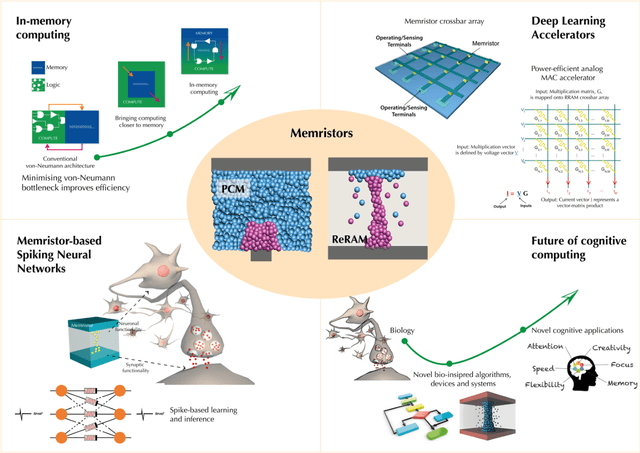


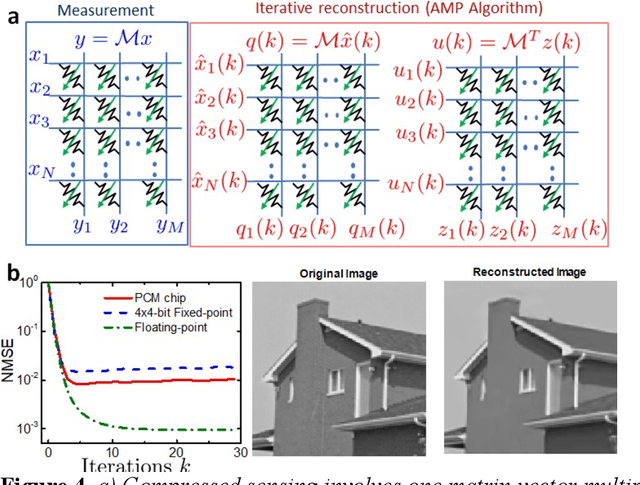
Abstract:Machine learning, particularly in the form of deep learning, has driven most of the recent fundamental developments in artificial intelligence. Deep learning is based on computational models that are, to a certain extent, bio-inspired, as they rely on networks of connected simple computing units operating in parallel. Deep learning has been successfully applied in areas such as object/pattern recognition, speech and natural language processing, self-driving vehicles, intelligent self-diagnostics tools, autonomous robots, knowledgeable personal assistants, and monitoring. These successes have been mostly supported by three factors: availability of vast amounts of data, continuous growth in computing power, and algorithmic innovations. The approaching demise of Moore's law, and the consequent expected modest improvements in computing power that can be achieved by scaling, raise the question of whether the described progress will be slowed or halted due to hardware limitations. This paper reviews the case for a novel beyond CMOS hardware technology, memristors, as a potential solution for the implementation of power-efficient in-memory computing, deep learning accelerators, and spiking neural networks. Central themes are the reliance on non-von-Neumann computing architectures and the need for developing tailored learning and inference algorithms. To argue that lessons from biology can be useful in providing directions for further progress in artificial intelligence, we briefly discuss an example based reservoir computing. We conclude the review by speculating on the big picture view of future neuromorphic and brain-inspired computing systems.
 Add to Chrome
Add to Chrome Add to Firefox
Add to Firefox Add to Edge
Add to Edge